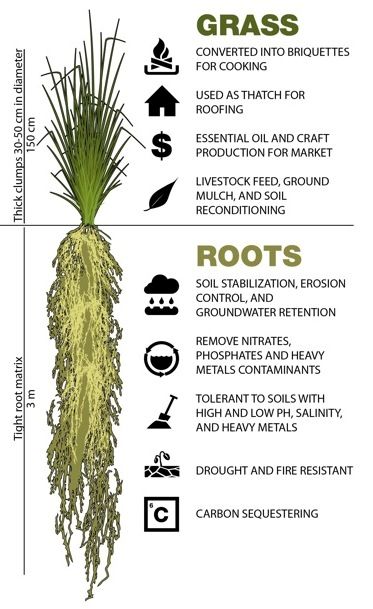
By George Munene
Vetiver grass is classed as the most cost-efficient living barrier in controlling soil erosion with semi-arid farmers reporting 40-50 per cent yield increases when using vetiver hedges on their farms.
Vetiver, which translates to ‘root that is dug deep’, penetrates to depths in excess of three meters in some soil types. These roots literally ‘nail the soil to the ground’.
It is a non-invasive (doesn't wander from where it's planted) perennial grass used in soil conservation and slope stabilisation.
“In protected fields, the implementation of The Vetiver System assists farmers by holding nutrients and moisture in their fields which both improve yields and extend the growing season.
In areas where flooding is a challenge vetiver grass spreads excess water across crop areas, equalizing the hydrological pressure, thus preventing or protecting the crop areas from being washed away,” explained Patrick Mukora, a board member of Plus-Kenya.
Plus-Kenya (Platform for Land Use Sustainability) is a registered NGO, that promotes the use of The Vetiver System to rehabilitate and rehydrate Kenya’s landscapes.
Related News: Hybrid Super Napier grass yields 4× regular varieties
Vetiver grass is better in preventing erosion than constructed earth or soil banks in that it is easier to construct and maintain; does not break even under heavy rain; hedges serve to redistribute water in the farm rather than divert it as is the case with artificial banks; while earth banks must follow contours with sharp bends obstructing ploughing, vetiver hedges follow a smooth course.
Vetiver also benefits crops with improved fertility, water infiltration, and good quality mulch.
Often planted as hedges, vetiver can also be used to help the soil retain moisture and fertility; protect crops against flood damage; function as wind and fire breakers; provide fodder when cut fresh every 4-6 weeks (dry vetiver hay is indigestible); remediation of contaminated water and land; make urine soaking beds for livestock, reduce pests (pull Chilo stem borers from maize as well as being a harbour for predator insects and form a sharp leaf barrier that snakes and rodents can't get through).

6-month old vetiver in Mandera
“For farmers in areas affected by droughts or floods, vetiver grass is an ideal pioneer plant, providing a stable foundation for other plants to establish,” Patrick pointed out.
Soil erosion is controlled by the grasses' stiff stems which reduce water speed curbing soil loss and water runoff. Soil deposited behind the hedge builds a natural terrace
Its strong deeply penetrative root system grows downward meaning it does not compete with neighbouring crops for food. This root system which grows to 3-4 meters makes it drought resistant.
Established hedges are resistant to overgrazing and fires.
It is adaptable to a range of local conditions, problematic soils, hard soil layers, and erratic rains. The grass can grow in highly acidic (pH4) and alkaline (pH8) soils. It is also largely resistant to pests, heavy metals, and toxins.
The grass has been promoted by Kenya Agriculture Research Institute (KARI) as a hedgerow to curb erosion. Its propagation has also been promoted by the National Environmental Management Authority (NEMA) within Nyanza.
Originally from India, Vetiver (Chrysopogon zizanioides), has been used in soil conservation especially in tea plantations and in essential oil production in Kenya since the early 1930s/40s.
Its roots do not invade adjacent areas as with grasses such as Kikuyu, Couch, and Bermuda. It often doesn’t flower and its seeds are sterile making it easy to domesticate.
Related News: KALRO boosts dual-purpose Teff grass production to help arid farmers combat drought
Related News: New highly nutritious Mombasa grass an option for arid farmers
Vetiver hedges should be established leaving no gaps (max distance 12-15cm) to be most effective. They are planted across slopes, along gullies or rills, and protect against soil erosion for life.
It is crucial that farmers plant the recommended Sunshine Vetiver strain as it is totally non-invasive. It is propagated vegetatively by the division of tillers or roots.
A list of authenticated vetiver growers across the country can be accessed here, www.vetiver.org
Write comment (0 Comments)
















